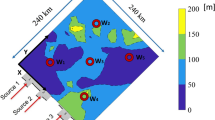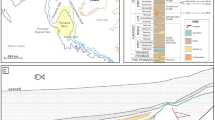Abstract
The dynamical evolution of sediments in basins, and their compaction, is the underpinning keystone on which rests the ability to model thermal history of the basin and hydrocarbon generation, migration, and accumulation histories. A presentation is given of the dynamical tomography method, which inverts dynamical indicators to evaluate the parameters in a 1-D fluid-flow/compaction model, including values dealing with geological events as well as values dealing with intrinsic, or assumed, lithologic equations of state. Synthetic tests illustrate the operation of the system. Using observed downhole quantities: total depth, formation thicknesses, variation of porosity, permeability, and total fluid pressure with depth from the Navarin Basin COST No. 1 well, Bering Sea, Alaska, the numerical algorithm was tested and found to be effective in a nonlinear inverse sense to determine and/or constrain the parameters entering quantitative models of dynamical sedimentary evolution. The predictions of present day total depth, formation thicknesses, porosity, permeability, and fluid pressure with depth are close to the measured data. The minimization provides the uncertainty in each parameter and so the geohistory of a well can be defined better.
Similar content being viewed by others
References
Armagnac, C., 1985, Thermal history of the National Petroleum Reserve, Alaska: M.S. Thesis, University of South Carolina.
Armagnac, C., Bucci, J., Kendall, C. G. St. C., and Lerche, I., 1989, Estimating the Thickness of Sediment Removed at an Unconformity Using Vitrinite Reflectance Data,in N. Naeser and T. H. McCulloh (Eds.), Thermal History of Sedimentary Basins, Chap. 13: Springer-Verlag, Berlin, p. 217–238.
Bethke, C. M., 1985, A Numerical Model of Compaction-Driven Groundwater Flow and Heat Transfer and Its Application to the Paleohydrology of Intracrationic Sedimentary Basins: J. Geophys. Res., v. 90, p. 6817–6829.
Bevington, P. R., 1969, Data Reduction and Error Analysis for the Physical Sciences: McGraw-Hill Book Co., New York.
Cao, S., and Lerche, I., 1990, Basin Modeling: Applications of Sensitivity Analysis: J. Pet. Sci. Eng., v. 4, p. 83–104.
Cao, S., Glezen, W. H., and Lerche, I., 1986, Fluid Flow, Hydrocarbon Generation and Migration: A Quantitative Model of Dynamical Evolution in Sedimentary Basins: Proc. Offshore Technol. Conf., v. 2, p. 267–276.
He, Z., and Lerche, I., 1989, Inversion of Multiple Thermal Indicators: Quantitative Methods of Determining Palaeoheat Flux and Geological Parameters IV. Case History Using Thermal Indicator Tomography: Math. Geol., v. 21, p. 523–541.
Kuckelkorn, K., Wang, X., and Lerche, I., 1990, Overthrusting History in the Austrian Alps: Case Study of Oberhofen 1: J. Geodynamics, v. 12, p. 101–120.
Lerche, I., 1988a, Inversion of Multiple Thermal Indicators: Quantitative Methods of Determining Paleoheat Flux and Geological Parameters. I. The Theoretical Development for Paleoheat Flux: Math. Geol., v. 20, p. 1–36.
Lerche, I., 1988b, Inversion of Multiple Thermal Indicators: Quantitative Methods of Determining Paleoheat Flux and Geological Parameters. II. The Theoretical Development for Chemical, Physical and Geological Parameters: Math. Geol., v. 20, p. 73–96.
Lerche, I., 1990a, Basin Analysis: Quantitative Methods, Vol. 1: Academic Press, Orlando, 562 p.
Lerche, I., 1990b, Basin Analysis: Quantitative Methods, Vol. 2: Academic Press, San Diego, 614 p.
Lerche, I., 1991, Inversion of Dynamical Indicators in Quantitative Basin Analysis Models. I. Theoretical Considerations: Math. Geol. v. 23, p. 817–832.
Pantano, J., and Lerche, I., 1990, Inversion of Multiple Thermal Indicators: Quantitative Methods of Determining Paleoheat Flux and Geological Parameters. III. Stratigraphic Age Determination from Inversion of Vitrinite Reflectance Data and Sterane Isomerization Data: Math. Geol., v. 22, p. 281–307.
Turner, R. F., McCarthy, C. M., Steffy, D. A., Lynch, M. B., Martin, G. C., Sherwood, K. W., Flett, T. V., and Adams, A. J., 1984, Geological and Operational Summary, Navarin Basin COST No. 1 Well, Bering Sea, Alaska. OCS Report MMS 84-0031; Anchorage, U.S. Dept. of the Interior, Mineral Management Service.
Welte, D. H., and Yukler, M. A., 1981, Petroleum Origin and Accumulation in Basin Evolution—A Quantitative Model: Am. Assoc. Pet. Geol. Bull., v. 65, p. 1387–1396.
Yukler, M. A., 1979, Sensitivity Analysis of Groundwater Flow System and an Application to a Real Case,in D. F. Merriam (Ed.), Geomathematical and Petrophysical Studies in Sedimentology (Computer Geology): Pergamon Press, New York.
Author information
Authors and Affiliations
Rights and permissions
About this article
Cite this article
Zhao, K., Lerche, I. Inversion of dynamical indicators in quantitative basin analysis models. II. Synthetic tests and a case history using dynamical indicator tomography. Math Geol 25, 107–123 (1993). https://doi.org/10.1007/BF00893268
Received:
Accepted:
Issue Date:
DOI: https://doi.org/10.1007/BF00893268




